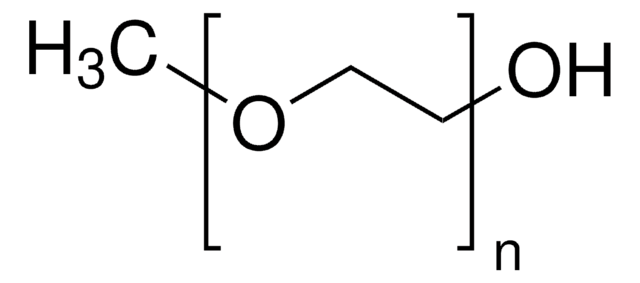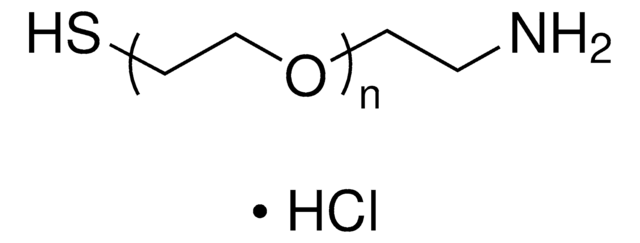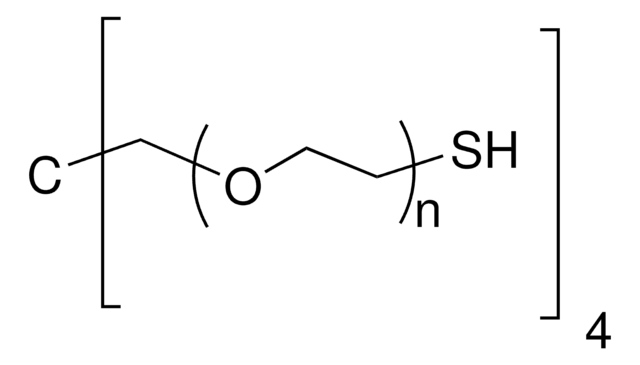Kluczowe dokumenty
729140
Poly(ethylene glycol) methyl ether thiol
average Mn 2,000, chemical modification reagent thiol reactive, methoxy, thiol
Synonim(y):
Glikol polietylenowy
About This Item
Polecane produkty
Nazwa produktu
Poly(ethylene glycol) methyl ether thiol, average Mn 2,000
Formularz
solid
Poziom jakości
masa cząsteczkowa
average Mn 2,000
przydatność reakcji
reagent type: chemical modification reagent
reactivity: thiol reactive
mp
50-55 °C
Ω-koniec
thiol
α-koniec
methoxy
architektura polimerowa
shape: linear
functionality: monofunctional
temp. przechowywania
−20°C
Szukasz podobnych produktów? Odwiedź Przewodnik dotyczący porównywania produktów
Powiązane kategorie
Zastosowanie
- Surface modification of polyaniline nanorods with thiol-terminated poly (ethylene oxide): This study explores the use of varying molecular weights of poly(ethylene glycol) methyl ether thiol for modifying the surface of polyaniline nanorods, aiming to enhance their dispersibility and functionality (DiTullio et al., 2018).
- Colorimetric determination of p-phenylenediamine using silver nanoparticles modified with poly (ethylene glycol) methyl ether thiol: The research demonstrates the use of poly(ethylene glycol) methyl ether thiol in modifying silver nanoparticles for the colorimetric determination of p-phenylenediamine, showcasing its application in analytical chemistry (Lee et al., 2017).
- Facile synthesis and self-assembly of amphiphilic polydimethylsiloxane with poly (ethylene glycol) moieties via thiol-ene click reaction: This article discusses the synthesis and self-assembly of amphiphilic copolymers using thiol-ene click chemistry, emphasizing the versatility of poly(ethylene glycol) methyl ether thiol in creating functional materials (Xia et al., 2015).
- Determination of polyethylene glycol end group functionalities by combination of selective reactions and characterization by matrix assisted laser desorption/ionization time of flight mass spectrometry (MALDI-TOF MS): This study highlights a method for characterizing end group functionalities of poly(ethylene glycol) derivatives using MALDI-TOF MS, where poly(ethylene glycol) methyl ether thiol plays a critical role in the analysis process (Zhang et al., 2014).
Hasło ostrzegawcze
Warning
Zwroty wskazujące rodzaj zagrożenia
Zwroty wskazujące środki ostrożności
Klasyfikacja zagrożeń
Eye Irrit. 2 - Skin Irrit. 2 - STOT SE 3
Organy docelowe
Respiratory system
Kod klasy składowania
11 - Combustible Solids
Klasa zagrożenia wodnego (WGK)
WGK 3
Temperatura zapłonu (°F)
Not applicable
Temperatura zapłonu (°C)
Not applicable
Wybierz jedną z najnowszych wersji:
Masz już ten produkt?
Dokumenty związane z niedawno zakupionymi produktami zostały zamieszczone w Bibliotece dokumentów.
Klienci oglądali również te produkty
Produkty
Progress in biotechnology fields such as tissue engineering and drug delivery is accompanied by an increasing demand for diverse functional biomaterials. One class of biomaterials that has been the subject of intense research interest is hydrogels, because they closely mimic the natural environment of cells, both chemically and physically and therefore can be used as support to grow cells. This article specifically discusses poly(ethylene glycol) (PEG) hydrogels, which are good for biological applications because they do not generally elicit an immune response. PEGs offer a readily available, easy to modify polymer for widespread use in hydrogel fabrication, including 2D and 3D scaffold for tissue culture. The degradable linkages also enable a variety of applications for release of therapeutic agents.
Global Trade Item Number
| SKU | GTIN |
|---|---|
| 729140-1G | 4061835563791 |
| 729140-5G | 4061832862880 |
Nasz zespół naukowców ma doświadczenie we wszystkich obszarach badań, w tym w naukach przyrodniczych, materiałoznawstwie, syntezie chemicznej, chromatografii, analityce i wielu innych dziedzinach.
Skontaktuj się z zespołem ds. pomocy technicznej












